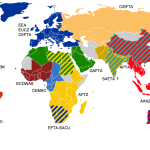There are four major trade blocs in current times that have the reputation and will to make a significant impact on international business process.

ASEAN
Association of Southeast Asian Nations (ASEAN) was established on August 8, 1967, in Bangkok (Thailand).
● Members − The member states are Brunei Darussalam, Cambodia, Indonesia, Laos, Malaysia, Myanmar, Philippines, Singapore, Thailand, and Vietnam.
● Goals − The goals of ASEAN are to (a) accelerate economic growth, social progress, and cultural development in the region and (b) promote regional peace and stability and adhere to United Nations Charter.
● ASEAN Economic Community (AEC) − The AEC is aiming to transform ASEAN into a single entity and a production powerhouse that is highly competitive and fully compatible with the global economy.
EU
The European Union (EU) was founded in 1951 by six neighboring states as the European Coal and Steel Community (ECSC). Over time, it became the European Economic Community (EEC), then the European Community (EC), and was ultimately transformed into the European Union (EU). EU is the single regional bloc with the largest number of member states (28).
● Members − Austria, Belgium, Bulgaria, Croatia, Cyprus, Czech Republic, Denmark, Estonia, Finland, France, Germany, Greece, Hungary, Ireland, Italy, Latvia, Lithuania, Luxembourg, Malta, Poland, Portugal, Romania, Slovakia, Slovenia, Spain, Sweden, The Netherlands, and the United Kingdom.
● Goal of EU − To construct a regional free-trade association of states through the union of political, economic, and executive connections.
MERCOSUR
Mercado Comun del Cono Sur (MERCOSUR) was established on 26 March 1991 with the Treaty of Assunción. The major languages spoken in this region are Spanish and Portugese.
● Members − Argentina, Brazil, Paraguay, Uruguay, and Venezuela. Bolivia is undergoing the process of becoming a full member. Associate members include Chile, Colombia, Ecuador, Guyana, Peru, and Suriname. There are associate members who can do preferential trade but not allowed to have tariff benefits like the registered members. Mexico has an observer status.
● Goals − Accelerate sustained economic development based on social justice, environmental protection, and reduction of poverty.
NAFTA
The North American Free Trade Agreement (NAFTA) was signed on 1 January 1994.
● Members − Canada, Mexico, and the United States of America.
● Goals − The goals of NAFTA are to (a) eliminate trade barriers among its member states, (b) promote an environment for free trade, (c) increase investment opportunities, and (d) protect intellectual property rights.


